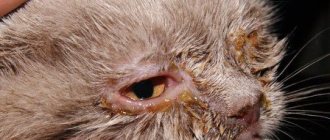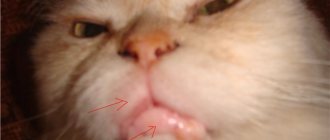White Cat Deafness Study
The fact of deafness of white cats interested scientists several decades ago. In 1997, a large-scale study of the problem was carried out, as a result of which several interesting facts emerged:
- Deafness resulting from the mutation process can be either complete or partial.
- Hearing loss affects about 20% of cats with white fur and non-blue eyes.
White cat of the Kao-mani breed with yellow eyes
- 40% of all cats with heterochromia (different eye colors) have hearing loss, which manifests itself in the ear next to the eye with a blue iris.
White Scottish Fold with different eyes
- 80% of blue-eyed white cats are deaf.
White British cat with blue eyes
Read the article: 20 breeds of white cats.
Why are white cats deaf?
In snow-white cats, the W gene is dominant in the genotype. Some mistakenly believe that it is responsible for albinism, but this has nothing to do with reality. The presence of the gene explains that only 2 out of 10 white pets, regardless of their breed, are truly deaf. This gene is also observed in other domestic animals. Hearing loss occurs in a kitten with different eyes, in a black, spotted or tabby cat. This is due to the fact that the gene is inherited, so some kittens are born deaf, regardless of the shade and color of their coat. The coat acquires a snow-white tone due to albinism, which is not associated with deafness.
Natural selection
Animals with pure white fur are extremely rare in nature. This coloring makes them vulnerable and reduces their chances of survival due to the lack of necessary camouflage. Therefore, the opportunity to purchase white cats today has been preserved only thanks to breeders and interest in such pets on the part of buyers. In the world, these animals make up no more than 5% of the entire population.
Previously, when the problem was not yet so obvious, breeders sometimes did not even realize that their white cat could not hear. Then he gave birth to offspring, and the deafness spread further along the family line. Today, such cats are not used for further breeding, which has significantly reduced the rate of spread of the problem among white-haired fluffies.
Norwegian Forest Cats are white
Genetics of deafness in cats
Scientists have studied and explained quite well the reason for the increased number of cases of deafness among white cats. It's all about the insidious mutant gene Dominant White (W-).
At the stage of embryo development, a certain number of melanoblasts begin to form near the neural tube, which must produce pigment and carry it to the hair follicles and retina. With normal genetic development, delivery occurs on time, and colorful kittens with green or yellow eyes are born. But as soon as a mutant appears in the blood, everything changes. It greatly inhibits the rate of advancement of melanoblasts. They do not have time to arrive to the skin and fill the follicles in time. The same is true for the retina of the eye. It turns out that the pigment does not get into them. Sometimes a small number of melanoblasts still reach their targets, so only certain areas of the body may appear white. Or the pigment reaches the iris only in a limited amount, which is why the kitten is born heterochromic, when one eye is blue and the other, for example, yellow. This phenomenon occurs not only among cats, but among other animals and even people.
Kao-mani with blue eyes
Other cells are also formed near the neural tube, which, in particular, are responsible for the normal development of the auditory system. The mutant also delays their spread. It was found that one dominant allele of the W gene can affect not only the color of the coat and eyes, but also cause deafness. The necessary groups of cells reach the middle ear when it has already formed incorrectly, and nothing can be corrected.
The effect of the gene continues to be studied because, as it turns out, kittens with white coat color and a congenital ear defect have several other deviations from the norm: they are less fertile and their viability is reduced. It turns out that the mutant affects almost all processes during the formation of the fetus, and not, as was commonly believed, responsible for only one trait - the presence of pigment.
Factors that increase the likelihood of deafness in white cats
The figure shows the likelihood of a cat being deaf depending on the color of its fur and iris. Hearing defects may affect two ears, or may appear in only one.
Among the entire cat population, no more than 1.5% are found that have white fur and blue eyes, one or both. Their geographical distribution is uneven.
As a result of research, it was found that white cats with long hair are more likely to have hearing defects than their short-haired counterparts. In addition, blue-eyed cats are 5 times more likely to develop middle ear degeneration than cats with eyes of other colors. Having only one blue eye doubles the risk of developing deafness compared to cats that do not have both eyes blue.
White Cymric
As a result of natural selection, cats with white fur have virtually no chance of survival in the wild for several reasons:
- Due to the likelihood of deafness, the ability to live normally and hunt successfully is reduced.
- There is a risk of developing photophobia, which makes it difficult to stay in the sun.
- Blue-eyed animals have difficulty seeing normally in the dark.
But people liked white cats so much that today the demand for such kittens is very high. This type of color is found in almost every breed, and breeders have learned to test a cat for deafness using the BAER test, which can be performed at any veterinary clinic. If suddenly a defect is discovered, then such a cat will not participate in further procreation.
Foreign white
How does it affect your pet's health?
Quite often, cats pay for different colors of the iris with hearing impairment, even complete hearing loss. With an equal degree of probability, an animal may be deaf in one ear or both.
One-sided deafness or significant hearing loss in one ear and complete loss in the other are also possible. The phenomenon occurs if the cause of different-colored eyes is a genetic factor, which often disrupts the development of the hearing aid. But this is not a rule, and the animal may turn out to be full-fledged.
Be sure to read:
Fat tail in a cat: what is it, normal or pathological, what to do, how to get rid of it, features of different breeds
Deafness is not found in all cats with unusual appearance.
Because of this, before selling kittens, a conscientious breeder usually obtains a veterinary report on the condition of the animal. A kitten with partial or complete deafness costs less than a fully hearing one.
Identifying the problem of deafness in a cat or kitten
Congenital deafness may not appear immediately. Sometimes kittens are born hearing, but due to a defect, less and less blood begins to flow to the deformed ear, and it stops hearing completely. This usually occurs at 3-4 weeks of life.
If only one ear is damaged, then sometimes the owner may not even realize it. The kitten quickly adapts to life with restrictions and begins to behave in the most normal way.
A short examination at a veterinary clinic will help identify the problem. But you can do this at home yourself. To do this, you need to perform some actions near the cat and monitor the reaction:
- Take a piece of paper and tear it.
- Rustle the foil.
- Tap on a hard surface.
- Make hissing sounds.
In this case, the cat should not see you for the reaction to be reliable. Ideally, he should doze with his back to you. If a cat hears, he will definitely react to the noise. If there is no reaction, then a more in-depth examination by a veterinarian is necessary.
Sometimes signs of deafness include purring too loudly and restless sleep.
White Persian cat
What to do if the cat is deaf, how to ensure safety
When deafness occurs in ordinary cats, it is usually associated with a certain disease that can be cured. The story is different with white cats. Their defect is congenital. Therefore, it cannot be treated. But this does not mean that such a pet will please you less. He will certainly become everyone's pet, but such a cat will require special care:
- Do not let him go further than the house or fenced garden area.
- Avoid contact with other animals unless they live together.
- Develop a series of gestures that will replace voice commands and help the cat understand what the owner wants to say.
- Build the skill of maintaining eye contact through rewards and repetition.
Even in the absence of hearing, the kitten will very soon begin to distinguish family members by the different vibrations from their steps. Deaf cats love their owners no less than hearing cats. The main thing is to provide the pet with a safe habitat, because they do not hear many signs of approaching danger - yard dogs or cars.
How to communicate with such a cat?
Of course, keeping deaf cats has its own characteristics. Owners will have to get used to the fact that much of the behavior of such animals will be unusual for them. They will never be able to successfully hunt birds. They won’t make hunters, because you can’t explain to a cat that a bird hears when someone is creeping up on it. This means you need to sneak up on her as quietly as possible.
Deafness in cats can bring them a lot of trouble, because they have to live in a world of hearing people and animals. Therefore, they need constant supervision. They do not need to be allowed outside alone, because they will not even hear a dog or other animal approaching them, which can greatly frighten them. It is even more dangerous to let such cats out onto the street where cars drive. Without hearing the car signal, the cat will not have time to jump away in time and may fall under the wheels.
Despite their peculiarity, white cats have a wonderful cat character. Most of them:
- gentle and affectionate;
- love to communicate (although their communication is of a slightly different nature);
- sensitive;
- They quickly get used to their owner and are devoted to him (although they will play with other family members with no less pleasure).
But their excessive sensitivity may cause them to become afraid of strangers.
Keeping white cats includes grooming their coat, as stains and dirt are especially noticeable on a white background. You will have to accustom the animal to taking baths. Let him know that this is necessary. After this procedure, be sure to treat the cat to something tasty that he especially loves.
In nature, such animals are very noticeable, which sometimes poses a threat to their life. Don't let cats walk alone, they simply cannot survive without people. Especially if the animal is deaf. If you see an “ownerless” white cat on the street, take it in and try to find the owner. She must have gotten lost.
If you understand that you can solve all these problems, feel free to make such a friend.











